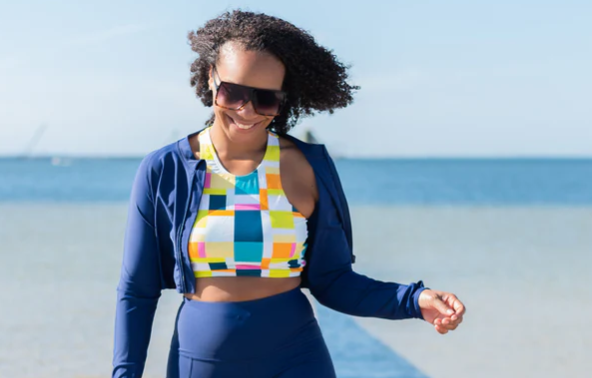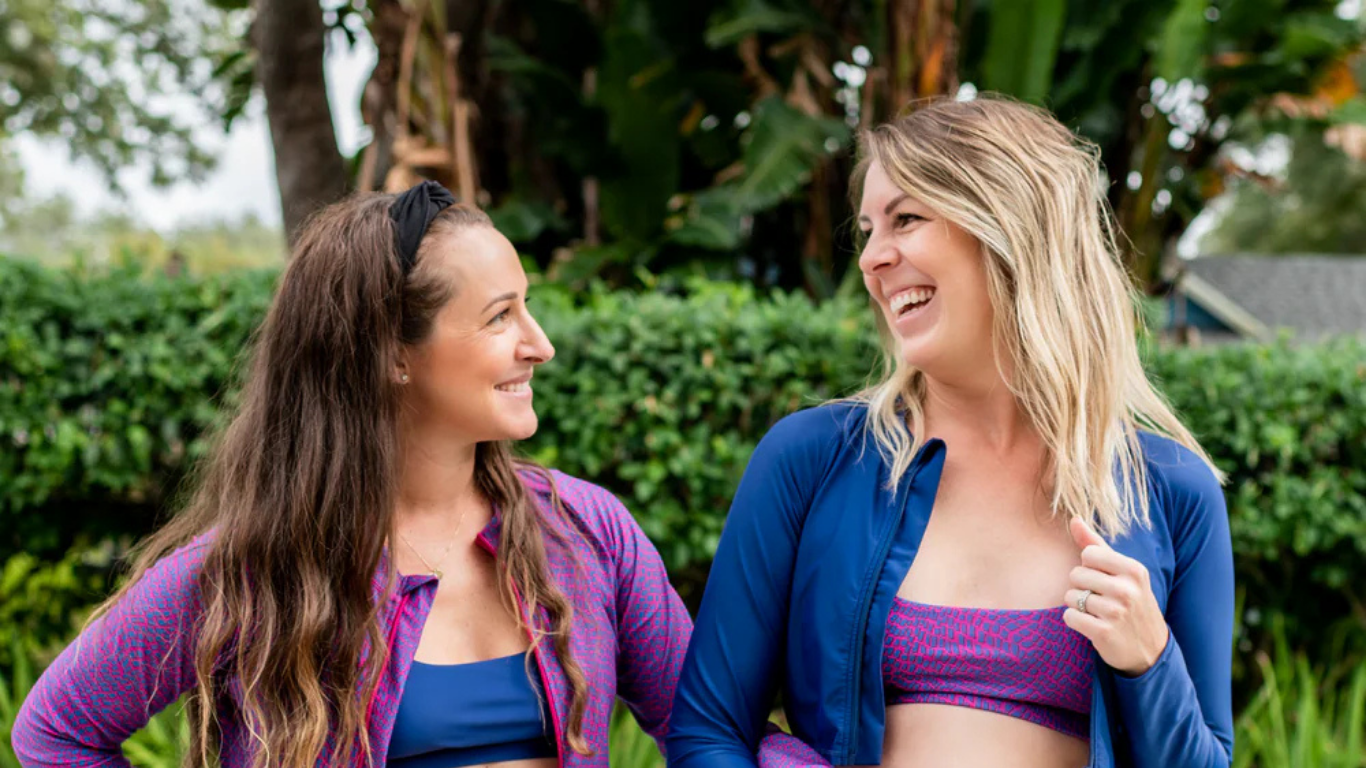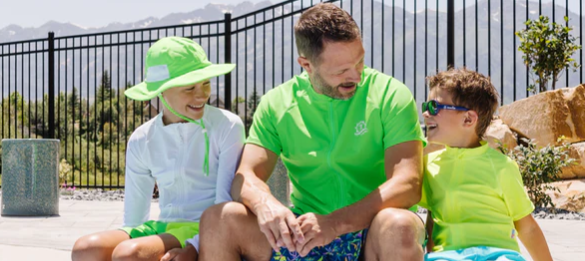
How tight should a rash guard be?
A rash guard should fit snugly against your skin without restricting movement. Imagine a second skin rather than a compression garment. You should be able to raise your arms overhead, twist your torso, and breathe comfortably without the fabric pulling, bunching, or digging into your skin.
A properly fitted rash guard maximizes sun protection, prevents chafing, and keeps you comfortable during water activities. We’ll discuss other reasons you want to get the right fit, helpful sizing tips, and some mistakes you’ll want to avoid when shopping for your next rash guard.
SwimZip offers stylish UPF 50+ swimwear for men, women, and children, from newborns to teens.
Why rash guards should fit right
As performance apparel, rash guards are meant to fit a particular way. Here’s how a bad fit causes your rash guard to do a bad job.
Abrasion resistance
Rash guards only protect the areas they cover. If a tight fit causes your rash guard to ride up and expose your belly, you’re gonna get a rash. Likewise, loose fits might bunch up or shift to expose skin that you want to protect when surfing, swimming, or diving.
UV protection
A bad rash guard fit exposes more skin to the sun. During peak hours, intense UV exposure can cause you to burn in under 15 minutes. If you don’t realize skin is exposed, you’ll get burned. Most rash guards offer UPF 50+ protection, which blocks 98% of UV rays. There’s no reason to accept a bad rash guard fit and add sunscreen when one of the main purposes of rash guards is sun protection.
Thermal protection
Properly fitted rash guards keep you warm longer. A light, compressive fit allows your body to warm a layer of water between the rash guard and your skin so you don’t get cold as fast. Some people purchase overly tight fits because they think they need to trap the water in, but that’s not necessary. A comfortable, snug fit works fine. A loose fit allows too much water circulation for a meaningful thermal effect.
Comfort
Besides technical rash guard properties, a bad fit just feels … bad. You don’t want to feel like a stuffed sausage. You don’t want to feel like your movement is constricted. But you also don’t want to feel like you’re swimming inside your loose clothing.
Signs of a good rash guard fit

You might put on a rash guard and think, “This is perfect,” but before you go with your gut, check for these signs of a good fit.
The fabric lies flat against your skin
A properly fitted rash guard shouldn't have loose, baggy areas or excess fabric. The material should follow the contours of your body smoothly without pulling tight or creating visible tension lines. You shouldn't see wrinkles or folds in the fabric when you're standing in a relaxed position.
At the same time, the fabric shouldn't compress your body or create a squeeze effect. If you see skin bulging around the seams or feel pressure around your torso, the rash guard is too small.
Sleeves reach your wrist bone
Long-sleeve rash guards should extend to your wrist bone when your arms hang naturally at your sides. This length provides maximum sun protection for your forearms without interfering with hand movement. The sleeves shouldn't ride up much when you raise your arms.
Short-sleeve rash guards should sit midway between your shoulder and elbow, covering the upper arm completely. The sleeve opening should fit snugly around your bicep without creating a tight band that restricts circulation.
💃 See our women’s short-sleeve rash guards for fun styles and comfortable fits.
The hem sits at your hips
The bottom hem of your rash guard should rest comfortably at hip level (low enough to overlap the waistband of your swim bottoms by a few inches). This overlap protects your lower back and stomach when you bend, stretch, or raise your arms.
The neckline sits comfortably
The neck opening should rest flat against your collarbone area without gaping or pulling. You should be able to move your head freely in all directions without restriction. The neckline shouldn't be so loose that it slides off your shoulder, but it also shouldn't dig into your neck or feel tight when you turn your head.
Mock neck or higher collar styles should sit smoothly against your neck without bunching or creating excess fabric under your chin.
Seams don't dig into your skin
Flatlock seams should lie completely flat against your body without creating pressure points or visible skin indentations. Run your hands along the side seams, shoulder seams, and underarm areas; you should feel the seam but not experience pinching or discomfort.
If seams leave red marks on your skin after a few minutes of wear, the rash guard is too small. Quality rash guards use flatlock stitching specifically to prevent chafing and irritation during extended wear.
You can move freely in all directions
Raise your arms, twist your torso, bend forward, and crouch down. The rash guard should move with you through all these motions without restricting your range of motion. You shouldn't feel the fabric pulling tight across your shoulders, back, or chest during any movement.
Try mimicking swimming strokes. The rash guard should stretch with these movements and then return to its original position against your skin.
SwimZip's signature zipper rash guards make it easy to achieve a performance fit without struggling.
How to get the right fit
In person
Store shopping makes fitting easy. Wear a thin shirt and try a few sizes and brands until you find something comfortable, snug, and unrestrictive.
When trying on a rash guard, perform these movement tests:
- Raise both arms straight overhead: The hem should stay at your hips without riding up. The underarm seams shouldn't pull or restrict your shoulder movement.
- Twist your torso side to side: The fabric should move with you without excessive pulling. You shouldn't feel constricted around your chest or back.
- Bend forward and reach toward your toes: The back of the rash guard should stay in place without lifting away from your lower back.
- Take a deep breath: The fabric should expand comfortably with your chest and ribcage.
The fabric should feel snug against your skin but not create pressure points. You shouldn't see loose, baggy areas, but you also shouldn't feel squeezed. Flatlock seams should lie flat without digging into your skin.
Online
Start by taking your measurements. Use a flexible measuring tape to measure your chest at its widest point, your waist at its narrowest point, and your hips at their widest point. Also measure from shoulder to hip to check torso length.
Compare your measurements to the brand you like’s size chart. Our sizing accounts for the stretch in UPF 50+ fabrics, so follow the chart rather than guessing based on regular clothing sizes. Rash guard sizing often differs from standard apparel sizing because the fabrics are designed to stretch and recover.
Shopping for children
Check sleeve length and torso coverage. Long sleeves should reach the wrist bone when arms are relaxed. The hem should sit comfortably at the hips (low enough to stay tucked during active play but not so long that it bunches up). If your child is between sizes, size up.
🏊 Browse our complete kids' sun-protective swimwear collection with UPF 50+ rated rash guards in sizes from newborn to teen.
Get the perfect fit with SwimZip
SwimZip makes comfortable, stylish rash guards for the whole family. Our patented fabric resists chlorine, saltwater, and all-day sun exposure. Our UPF 50+ swimwear holds the Skin Cancer Foundation Seal of Recommendation for dermatologist-tested sun defense. All of our rash guards have our signature front zipper for easy changes and performance fitting.
☀️ Shop our rash guards and find your fit today.
Rash guards FAQ
Should I size up if my child is between sizes?
If your child is growing and falls between two sizes, sizing up by one size is reasonable. The rash guard will feel slightly loose initially but should still provide adequate coverage and sun protection. Avoid sizing up more than one size, as excess fabric compromises safety and sun protection.
Can rash guards stretch out and become too loose?
The elastic fibers in rash guard fabric can relax over time with repeated wear, exposure to chlorine, and washing. Proper care extends the life of the fabric's stretch:
- Rinse in cool fresh water after each use.
- Avoid harsh detergents.
- Air dry rather than using a dryer.
If your rash guard has stretched to the point where it no longer stays in place or gaps away from your skin, it's time to replace it.
Do short-sleeve and long-sleeve rash guards fit differently?
Long-sleeve rash guards typically feel snugger around the shoulders and underarms because there's more fabric to pull when you raise your arms. When trying on long sleeves, pay extra attention to shoulder mobility and whether the sleeves restrict your arm movement. The torso fit should be consistent between short and long-sleeve versions of the same size.
🎓 Learn more about short-sleeve vs long-sleeve rash guards.
Should kids wear anything under a rash guard?
Most kids don't need to wear anything under a rash guard since they're designed to be worn directly against the skin. Girls might choose to pair a rash guard with swim bottoms or a tankini bottom, depending on coverage preferences. Boys typically wear rash guards with swim trunks or board shorts. Adding layers under a performance-fit rash guard can create bunching and discomfort.
🎓 Learn more in our guide on what to wear under a rash guard.
Are SwimZip's neon rash guards the same fit as solid colors?
Yes, all SwimZip rash guards follow the same sizing regardless of color or pattern. Our high-visibility neon swimwear has the same UPF 50+ protection and fit as our other collections. Bright colors make it easier to spot children in crowded pools, lakes, and beach areas.
🎓 Learn more about why kids should wear neon bathing suits for water safety.
Further reading
Does UPF wash out of clothing?
Where should I buy a swimsuit?




Leave a comment
This site is protected by hCaptcha and the hCaptcha Privacy Policy and Terms of Service apply.